Jyotir-lingam: The Column of Light
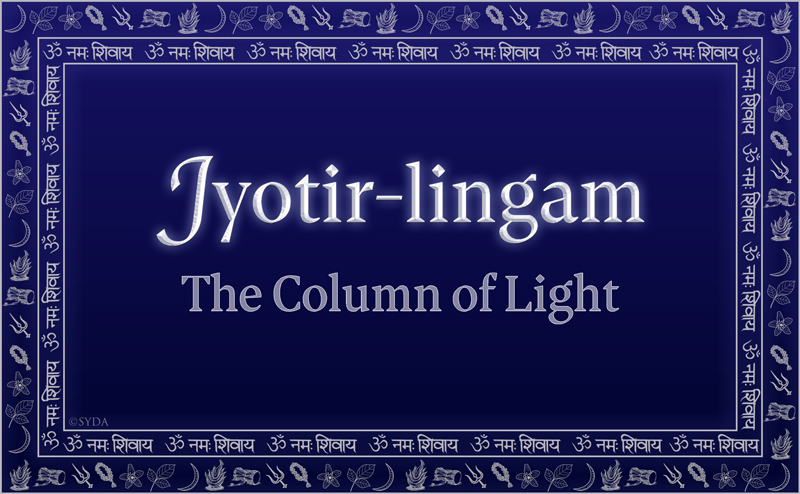
An Exposition by Ami Bansal
One of my earliest introductions to the greatness of Lord Shiva—the supreme Lord whom we honor on Mahashivaratri—was Shri Guru Gita. As a young person who grew up studying the teachings of my Guru, Shri Gurumayi Chidvilasananda, and regularly visiting Gurudev Siddha Peeth, I knew that Shri Guru Gita was among the most sacred scriptural texts on the Siddha Yoga path. This svadhyaya text, which was imparted by Lord Shiva to Goddess Parvati, always fascinated me for its riveting exposition on the nature of Shri Guru. In its teachings, I found direction for how to understand, value, and worship my Guru.
One afternoon, during a visit to Gurudev Siddha Peeth when I was around eleven years old, I picked up my svadhyaya book and began to read and study in detail the meaning of the verses of Shri Guru Gita. It took me a few days to learn about each of the hundred and eighty-two verses that Lord Shiva conveys in this scripture. I focused on every single Sanskrit word, trying to understand its meaning. By the end of my study, one thing became very clear to me, and that was Lord Shiva’s teaching:
न गुरोरधिकं न गुरोरधिकम्।
na guror-adhikaṁ na guror-adhikam ।
There is nothing greater than Shri Guru.
Indeed there is nothing greater than Shri Guru.1इदमेव शिवं त्विदमेव शिवम्।
idam eva shivaṁ tv-idam eva shivam ।
The Guru principle is Shiva.
Indeed, the Guru principle is Shiva.2
I remember feeling relieved to have this clarity that Shri Guru is, in fact, supreme Shiva—that Lord Shiva is not different from my Guru. From then on, whenever I repeated Om Namah Shivaya, the chaitanya mantra, the mantra given by Shri Guru and enlivened by the Guru’s shakti, I knew that I was honoring the presence of my Guru, who is the supreme Lord Shiva and the Self within me.
In the Indian scriptural tradition, Lord Shiva is not just one of many gods; he is Mahadeva, the greatest of all gods. At the same time, Lord Shiva holds the most exalted seat of the Adi-guru, the primordial and foremost Guru. He is the embodiment of supreme Consciousness and the teacher of all forms of divine knowledge, including yoga, meditation, music, and dance. He is the Guru of many of the gods and sages and has revealed innumerable scriptures that have led thousands of seekers, across millennia, toward Self-realization.
In Shri Guru Gita, Lord Shiva himself explains the meaning of this word “Guru”:
गुकारस्त्वन्धकारश्च रुकारस्तेज उच्यते।
अज्ञान-ग्रासकं ब्रह्म गुरुरेव न संशयः॥gukāras tv andhakāraś ca rukāras teja ucyate ।
ajñāna-grāsakaṁ brahma gurur eva na saṁśayaḥ ॥The syllable “gu” represents darkness, and the syllable “ru” signifies light.
Without a doubt, Shri Guru is the Supreme Absolute that devours and destroys ignorance.3
Thus, the true “Gu-ru” is the one who takes us away from the obscurity of illusion and the darkness of ignorance and brings us into the light of knowledge and the divine awareness of our own Self.

One of the most revered and profound symbols of Lord Shiva is the shiva-lingam. The story of how the shiva-lingam came to be is told by Lord Brahma in the Linga Purana.
The story begins with Lord Brahma and Lord Vishnu in the celestial realms, discussing which of them is greater. As they debate, a magnificent column of light appears in front of them. The light is phenomenally refulgent, yet at the same time, its presence is perfectly soothing and calm.
In the Linga Purana, Lord Brahma narrates his experience of seeing this lingam:
ज्वालामालासहस्त्राढ्यं कालानलशतोपमम्।
क्षयवृद्धिविनिर्मुक्तमादिमध्यांतवर्जितम्॥
अनौपम्यमनिर्देश्यमव्यक्तं विश्वसंभवम्।jvālāmālāsahastrāḍhyaṁ kālānalaśatopamam ।
kṣayavṛddhivinirmuktamādimadhyāṁtavarjitam ॥
anaupamyamanirdeśyamavyaktaṁ viśvasaṁbhavam ।It had innumerable clusters of flames that were comparable to so many all-consuming fires. Its light was steady, with no decline or increase. The lingam was matchless, pre-eminent, and inexplicable. It was the source of the universe.4
Awestruck by the breathtaking brilliance of this light, Lord Brahma and Lord Vishnu pause their debate. They both wish to know more about this infinite illumined pillar. Lord Brahma takes the form of a swan and attempts to find its beginning, and Lord Vishnu, assuming his avatara as a boar, endeavors to look for the end. Yet their efforts are in vain. They cannot come close to the source or end of this light. As they are realizing this, they see, emerging from within the center of this column, the resplendent form of a man. It is Lord Shiva.
What Lord Brahma and Lord Vishnu were beholding in this story was the primordial shiva-lingam—the svayambhu, or self-manifested lingam; the jyotir-lingam, the column of light, the infinite blazing flame that simply is, that simply exists, and that is the glowing backbone of this entire cosmos.
In the Linga Purana, Lord Brahma further described the sight of the first shiva-lingam to an assemblage of gods:
तदा समभवत्तत्र नादो वै शब्दलक्षणः।
ओमोमिति सुरश्रेष्ठाः सुव्यक्तः प्लुतलक्षणः॥tadā samabhavattatra nādo vai śabdalakṣaṇaḥ ।
omomiti suraśreṣṭhāḥ suvyaktaḥ plutalakṣaṇaḥ ॥O excellent gods, then from the column of light arose the thundering primordial sound AUM. It was a lucid, distinct, long, and lingering sound.5
This shiva-lingam was therefore not different from the resonance of the primordial sound AUM, and as such, it constituted within it all the Vedas and all knowledge. The Linga Purana further says that the light of the lingam surpassed the luminosity of the sun, moon, and fire. The Purana describes Lord Shiva in this form as shuddha-sphatika, the pure, effulgent crystal that is devoid of attributes, that is taintless, undisturbed, and free from the pairs of opposites. This lingam was the universal Self; it was brahmanda, the “cosmic egg” that represented the entire cosmos and from which this whole universe arose.
On the Siddha Yoga path, we learn from Gurumayi’s teachings, and from our own experience, that this cosmic column of light is within each of our beings. In visual depictions of the subtle body, the shiva-lingam is often shown to be seated in the muladhara chakra, where the latent Kundalini Shakti resides. This chakra is the base of the column of light, which rises all the way up to the crown of the head.
As seekers, our journey to Self-knowledge begins when we receive Shri Guru’s grace in the form of shaktipat diksha. As we steadily follow the guru-marga, the path shown by the Guru, this inner shakti that the Guru has awakened within us rises upward through the column of radiance until it reaches the sahasrara, the thousand-petaled lotus in the crown of the head, which is described in the Indian scriptures as the abode of Sadashiva, the beneficent Lord Shiva. It is here that Mahakundalini Shakti becomes one with Mahadeva, the great Lord Shiva, and the disciple comes to experience perfect unity with their beloved Guru and with their inner Self.

The goal of all outer worship we do on the Siddha Yoga path is to lead us to the Self within. The shiva-lingam symbolizes both the inner pathway of light treaded by Mahakundalini Shakti and the goal of that mystical passage. When we worship the shiva-lingam, we are worshiping the supreme light of the Self—the formless form of the Adi-guru that resides in the cave of the Heart.
The shiva-lingam can take different forms. Many of the shiva-lingam in India are naturally occurring; they are svayambhu, self-manifested, and as such, their shapes vary. Most frequently they are in the shape of a large oval that represents the column of light, or a circular mound that symbolizes brahmanda, the cosmic egg, the source of all creation.
The man-made shiva-lingam that are installed in many temples and homes are usually made of stone and have a tall vertical cylinder that is rounded at the top and inserted into a pedestal that sits on a base. The cylinder represents the column of light. The top part of the cylinder (the part of it that is visible) represents Lord Shiva. The midsection of the cylinder, which is inside the pedestal and therefore not visible, represents Lord Vishnu. And the bottom section of the cylinder (inside the base and also not visible) represents Lord Brahma. The pedestal itself represents the Goddess, the supreme Shakti.
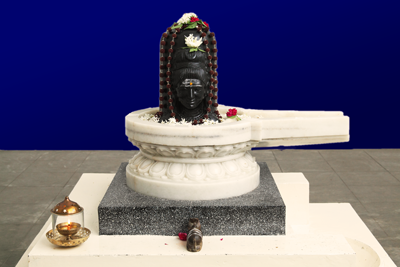
One of the meanings of the word lingam in the Sanskrit language is “mark” or “symbol.” The shiva-lingam symbolizes the whole universe—the energies of creation, sustenance, and dissolution, and most importantly, the supreme Shakti, the power that reveals this manifestation. Shiva and his Shakti are inseparable.
The shiva-lingam is most often worshiped by doing a simple abhishek. After the abhishek, one can also anoint the shiva-lingam with fragrant oil or sandalwood paste, and then offer flowers and leaves that are sacred to Lord Shiva (such as lotus flowers and bilva leaves) by placing them on the top of the lingam. It is traditional to then light a lamp, offer incense, and chant or recite the mantra Om Namah Shivaya.

According to the legends of the Puranas, after the Adi-guru Shiva first appeared in the heavenly realms to Lord Brahma and Lord Vishnu, he manifested through the ages as a dazzling column of light, the jyotir-lingam, in various locations to protect and guide his devotees. It is said that whenever Lord Shiva appeared, his devotees asked him to stay in that location forever, and so he took the form of a physical lingam for the benefit of humanity.
As the Shiva Mahapurana, one of the Indian scriptures that expounds on the nature of Lord Shiva, says:
लोकानामुपकारार्थं स्वलिंगं चाप्यकल्पयत्।
तल्लिंगं पूजयित्वा तु सिद्धिं समधिगच्छति॥lokānāmupakārārthaṁ svaliṃgaṁ cāpyakalpayat ।
talliṃgaṁ pūjayitvā tu siddhiṁ samadhigacchati ॥He, the supreme Lord Shiva, created his form
as the lingam for the benefit and upliftment of the worlds.
The devotee attains perfection by worshipping that form.6
There are twelve main jyotir-lingam in India. To this day, these jyotir-lingam are visited by seekers, and they are considered to be some of the most sacred shrines to Lord Shiva. The temples created around them are sanctuaries of spiritual energy.
The jyotir-lingam shrines are all located by water—either on the banks of a river, close to the sea, or near another body of water such as a lake or a pond. Why is this choice of location for the supreme Self to become manifest so noteworthy? For both practical and philosophical reasons. Practically, because water is the source of life, it would be easier for people to settle around the temple if there were water there; the water could be used for drinking, bathing, and growing food. Philosophically, it is believed that water held and enhanced the spiritual power of a place of worship.
The twelve jyotir-lingam are numbered according to their sequence of manifestation as described in the Shiva Mahapurana. Each of them has specific import and embodies particular attributes of Lord Shiva.
For Siddha Yogis, the jyotir-lingam are of special significance because Baba Muktananda and Shri Gurumayi have visited and offered puja to nearly all of them in the course of their yatras, their pilgrimages around India.
Somanatha
The first jyotir-lingam is Somanatha, which means “lord of the moon.” Soma is a name for the moon and natha means “Lord.” Located on the shores of the Arabian Sea in the region of Veraval, Gujarat, Somanatha is said to be close to the Triveni Sangam, the confluence of the Hiranya, Kapila, and mythological Sarasvati rivers.
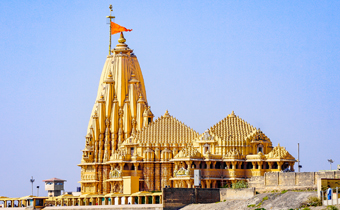
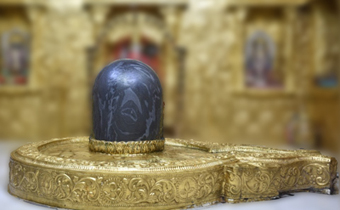
According to the Shiva Mahapurana, it was here that Chandradeva, the deity of the moon, engaged in fervent prayer to Lord Shiva. The story goes that Chandradeva had angered Prajapati, the son of Lord Brahma, and so Prajapati cursed Chandradeva to lose his identity and all his luster. Pleased with the moon god’s prayer, Lord Shiva appeared before Chandradeva as a shimmering light and gave him the blessing to wax and wane but not lose his luster. Lord Shiva also blessed the moon by giving him, in his crescent form, a place in his own locks. Since then, Lord Shiva has been known as “Somanatha,” the lord of the moon.
In Sanskrit, the word soma also means “nectar.” According to Shri Guru Gita, the inner Guru dwells in the region of the sahasrara, which is enveloped in chandra-prakasha7, the nectarean rays of the moon.
Mallikarjuna
Mallikarjuna, the second jyotir-lingam, is in the region of Shrishailam in the state of Andhra Pradesh. It is situated on a hilltop by the river Krishna.
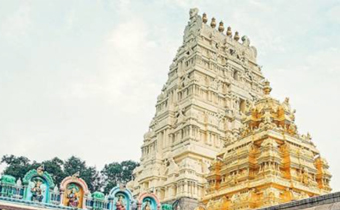
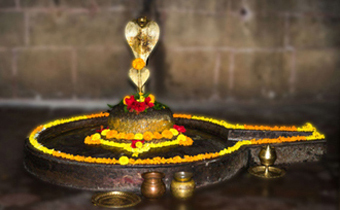
“Mallika” is a name of Goddess Parvati, and “Arjuna” is a term for Lord Shiva. Legend has it that Mallikarjuna is an abode of both Lord Shiva and Goddess Parvati; it is the seat of Lord Shiva in the form of the jyotir-lingam, and it is also a shakti peeth, a seat of the supreme Goddess.
Mallikarjuna is the bestower of health and prosperity and ensures the welfare of the world. The Shiva Mahapurana says that by doing puja to Lord Shiva in his form as Mallikarjuna, one is freed from all misery and attains supreme happiness. “Mallika” is also the name of a type of fragrant jasmine flower that is very dear to Lord Shiva.
Many saints and sages have expressed their adoration of Lord Shiva in the form of Mallikarjuna. This was, for example, the form of Lord Shiva that the poet-saint Shri Akkamahadevi wrote about in her poems and songs. She addressed him as her “beloved Lord as white as jasmine.” It was also here in Shrishailam that the revered sage Adi Shankaracharaya composed the Shivananda Lahari (“The Waves of Lord Shiva’s Bliss”), a hundred-verse hymn in praise of Mahadeva.
Baba Muktananda visited and offered puja to Mallikarjuna on many occasions. During a visit in 1973, Baba performed abhishek to the jyotir-lingam, and then took the rudraksha mala he was wearing around his neck and put it on the shiva-lingam. Then he went into deep meditation.
Afterward, when Baba went to retrieve the mala, it wouldn’t budge! It was as good as stuck to the jyotir-lingam. Baba smiled and said, “It looks like he likes my mala. He wants my mala.”
Then Baba asked the lingam, “Will you not give my mala back?” When he went to retrieve the mala again, it had loosened and it came off readily. Baba put the mala around his neck and said to the priest of the temple: “Lord Shiva wanted my mala because this mala was given to me by my Gurudev Bhagavan Nityananda.”
Mahakaleshvara
On the banks of the river Shipra in the city of Ujjain in Madhya Pradesh is the residence of Lord Shiva in the form of Mahakaleshvara. Maha-kala means “supreme Time” and ishvara is “Lord” or “ruler.”
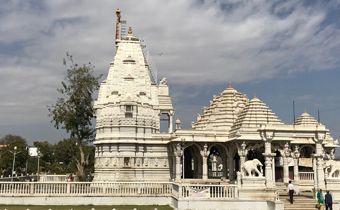
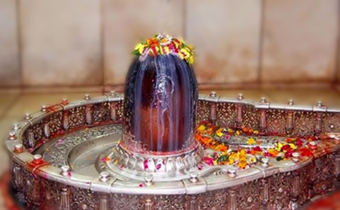
In his personification as Mahakaleshvara, Lord Shiva is venerated as the sovereign of all time, and therefore also as Yama, the lord of death. When a sadhaka worships Mahakaleshvara, they are honoring the Adi-guru who is not bound by time, and who grants the experience of that which is timeless and eternal. According to the Shiva Mahapurana, Mahakaleshvara also gives blessings and protection to everything that is bound by time, which includes nature and the physical body.
Omkareshvara
The fourth jyotir-lingam is Omkareshvara on the banks of the sacred Narmada River in the city of Khandva in Madhya Pradesh. Omkara-ishvara literally means “the Lord of the primordial sound AUM.”

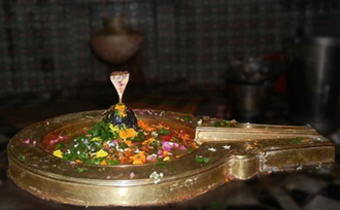
Omkareshvara is the essence and the soul of AUM. In this form, the great Adi-guru is honored as the sovereign of all sounds, letters, and mantras. He is the governing lord of matrika-shakti, the power that gives meaning to words. By practicing mantra japa, by reciting the sacred texts, by chanting, and by studying the teachings of the Guru, a sadhaka can better understand and recognize the presence of Omkareshvara in all sounds and language.
Kedarnatha
Seated among the snow-clad mountains and picturesque green meadows of the majestic Himalayas is the fifth jyotir-lingam: Kedarnatha, the “lord of the meadows.” The river Mandakini, a tributary of the sacred river Alakhananda, originates close to Kedarnath.
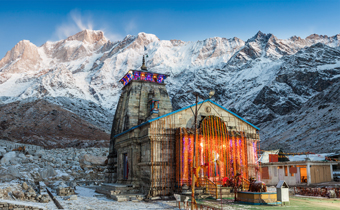

The temple to Kedarnatha is believed to have been built by the Pandavas centuries ago at the conclusion of the war narrated in the Indian epic Mahabharata. It is part of one of the most renowned pilgrimages in India which is made by thousands of seekers each year. According to the Shiva Mahapurana, by worshiping Lord Kedarnatha, one is freed from the cycle of death and rebirth.
Bhimashankara
Bhimashankara is the sixth jyotir-lingam and is situated in the lush forests of Maharashtra, close to the city of Pune. It is located at the source of the Bhimavati River.

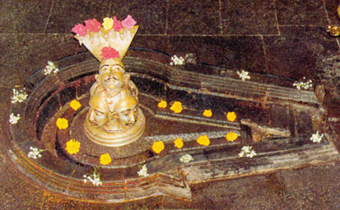
Lord Shiva is known as “Bhima-shankara” because he defeated the wicked demon Bhima, who was a terror to all virtuous people who believed in God. Bhima represented anger, envy, and pride. In his form as Bhimashankara, the Adi-guru destroys negative qualities within a disciple.
Kashi Vishvanatha
Situated on the banks of the holiest river Ganga is the sacred city of Varanasi, the abode of the seventh jyotir-lingam—Lord Shiva in the form of Kashi Vishvanatha. This is one of the most revered shrines in all of India.
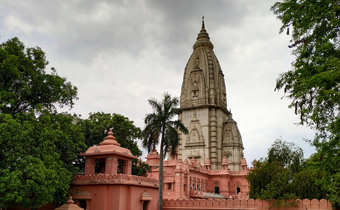

Vishvanatha, or Vishveshvara, is a name of Lord Shiva that means the “lord (or ruler) of the universe.” Varanasi, which is also popularly known as Kashi, is considered to be one of the oldest continually inhabited cities in the world. In addition to being the home of a jyotir-lingam, Kashi Vishvanatha is also a shakti peeth, the seat of the supreme Shakti. Goddess Parvati resides here in her form as Ma Annapurna, the supreme Mother who nourishes the entire universe.
Tryambakeshvara
Tryambakeshvara, the eighth jyotir-lingam, is close to the city of Nashik in Maharashtra, on the Brahmagiri hills. This sacred sanctuary is also the place of origin for the river Godavari.
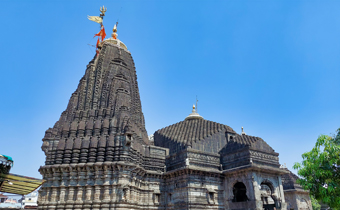
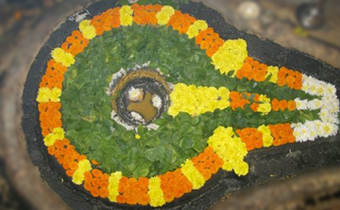
“Tryambakeshvara” means “the lord with three eyes.” Lord Shiva’s third eye, in the middle of his forehead, signifies the inner eye, which is constantly looking within while still perceiving and interacting with the world outside. This inner eye of viveka, or discrimination, protects a sadhaka from their own ignorance, lack of awareness, and inner enemies.
This shiva-lingam is unique because it has three mounds of lingams, which represent Lord Shiva, Lord Brahma, and Lord Vishnu.
Baba Muktananda loved to visit Tryambakeshvara. He even took up residence close to the shrine at one point during his sadhana, staying there for the entirety of chaturmasya, the four months of the monsoon season dedicated to spiritual practice. Later, in the 1960s, Baba began visiting Tryambakeshvara every year with a group of devotees to offer puja to Lord Shiva, meditate, and have satsang.
Vaidhyanath
Vaidhyanath, “the supreme healer,” is the ninth jyotir-lingam, and it is located in Deoghar in Jharkhand, India. The temple is close to the consecrated Shiva-ganga pond.
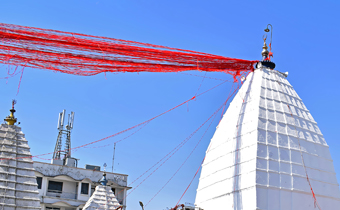

This jyotir-lingam is worshiped as the form of Lord Shiva who heals his devotees of all diseases that trouble the mind, the body, and the heart, and who leads them to become perfectly sva-astha—established in their own inner Self.
Nageshvara
Close to the ocean near the city of Dvaraka in Gujarat is the tenth jyotir-lingam: Nageshvara, the “lord of the serpents.” It has several sacred lakes in its vicinity, such as the Gopi Talav and the Bhimgaj Talav.

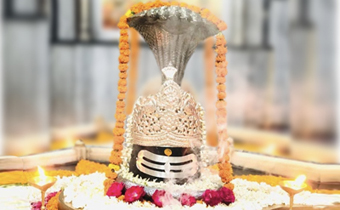
The Nageshvara lingam is in the shape of a tri-mukhi rudraksha, a rudraksha bead that has three distinct sides. Because it is close to Dvaraka, the home of Lord Krishna, it is believed that this jyotir-lingam was often worshiped by Lord Krishna. Lord Nageshvara is said to free one of all inner poisons, such as hatred, anger, and envy.
Rameshvara
The eleventh jyotir-lingam, Rameshvara—the “lord of Rama”—is at the tip of the Indian subcontinent, on a little island located between peninsular India and Shri Lanka. There are many tirthas, tanks of sacred water, that are located in and around the temple complex in Rameshvara, and it is a tradition for devotees visiting the temple to bathe in these tirthas before receiving darshan of Lord Shiva.
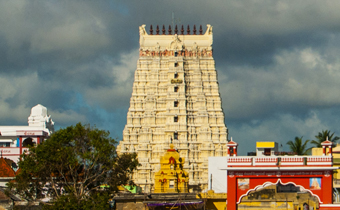

According to the Ramayana, it was here, at the southernmost tip of India, that Lord Rama worshiped Lord Shiva before crossing the ocean to Lanka and fighting the demon Ravana. Lord Shiva appeared to Lord Rama and blessed him to be victorious. Lord Rama then humbly requested that Lord Shiva dwell in this place for generations to come and continue to bless humankind.
The Adi-guru in his form as Rameshvara Mahadeva grants courage, strength, and the blessings to be victorious in one’s endeavors to do good and to uphold dharma.
Grishneshvara
The twelfth and the final jyotir-lingam is Grishneshvara Mahadeva, which is close to the city of Aurangabad in Maharashtra. Lord Shiva in his form as Grishneshvara is the lord of compassion, granting forgiveness, happiness, and salvation to his devotees. This form of the Adi-guru is a bestower of unsurpassable grace and blessings.
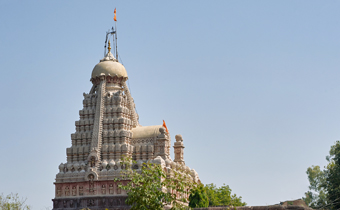
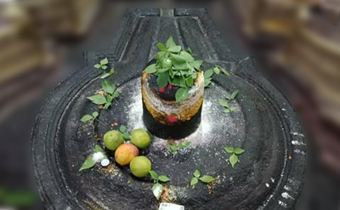
Both Baba and Gurumayi have visited the temple at Grishneshvara. Gurumayi visited Grishneshvara in the late 1980s at the commencement of one of her yatras, or pilgrimages, throughout India. Gurumayi and the Siddha Yogis accompanying her recited Shri Guru Gita in this temple, performed abhishek to the jyotir-lingam, and chanted the initiation mantra of the Siddha Yoga lineage: Om Namah Shivaya.

I love reflecting on the nature and power of the shiva-lingam because it evokes for me the divine light within, the light that Gurumayi has awakened in me and which I associate with her presence and darshan. Thinking about the shiva-lingam, worshiping the shiva-lingam always puts me in touch with my deep gratitude to my Guru.
Around twenty years ago, I was part of a group of Siddha Yogis that accompanied Gurumayi to Bhimeshvara Mahadeva, the temple to Lord Shiva that is next to Bhagavan Nityananda’s Samadhi Shrine in the village of Ganeshpuri. After Gurumayi offered puja to the shiva-lingam, we sat in the sanctum sanctorum for meditation. I remember sitting there with my eyes softly open, looking at Shri Gurumayi and at the shiva-lingam. In that moment I experienced this inimitable sense of oneness between the two; the divine resplendent shakti emanating from both the shiva-lingam and my Guru were the same. I offered my inner salutations to both—to the form of Adi-guru and to my Sadguru. I felt that I was seeing God worshiping God, the Self meditating on the Self. And I, too, having received the inner awakening from my Guru, was there, somewhere, connected to this divine energy—connected through the guru-mantra I repeat, through the guru-seva I offer, through my study and my practice of Gurumayi’s teachings, and through my devotion to my beloved Shri Guru.

1, 2, 3, 7Shri Guru Gita, verses 96, 97, 23, 91; English translations © SYDA Foundation 2022.
4, 5Linga Purana, 17.34–35 and 17.49; English translations © SYDA Foundation 2022.
6Shiva Mahapurana, 8.1.17; English translation © SYDA Foundation 2022.


